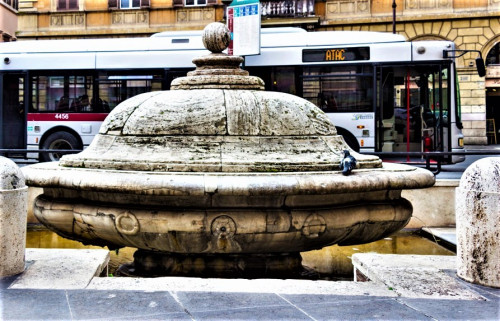
Fontana della Terrina, Piazza della Chiesa Nuova
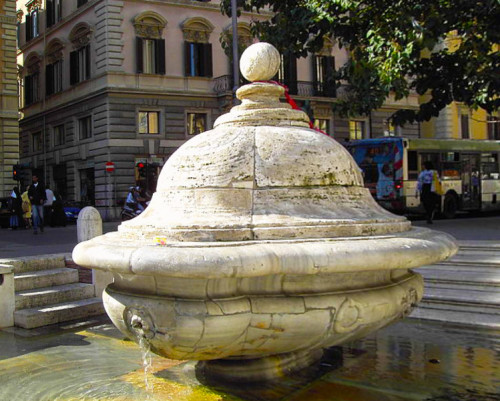
Fontana della Terrina, Piazza della Chiesa Nuova
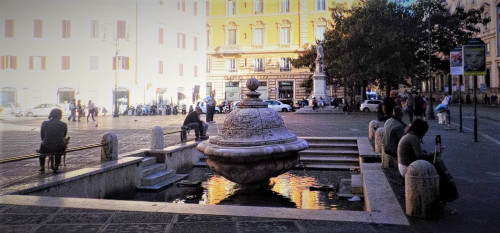
Fontana della Terrina
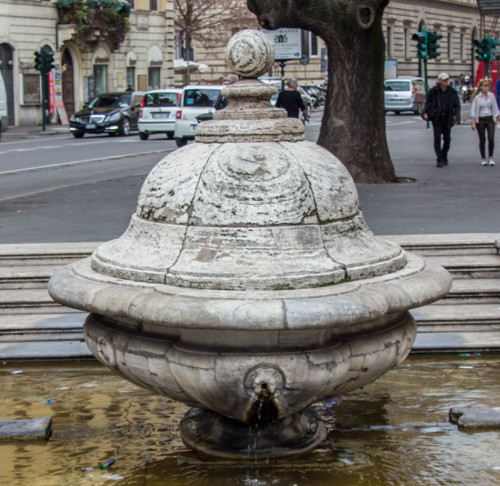
Fontana della Terrina, Piazza della Chiesa Nuova
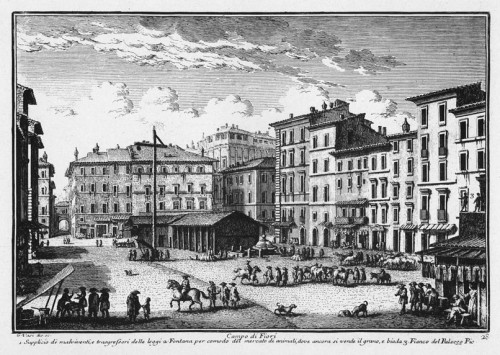
Campo de' Fiori, Giovanni Vasi, pic. Wikipedia
Rome is full of fountains, monstrous such as the di Trevi, large, small, and tiny ones, hidden in the narrow alleys or unexpectedly appearing upon small squares. They have always been the calling card of the Eternal City, its pride, decoration, but also a place of respite and rest. Some of them are veritable pearls of art, but there is also a good number of truly bizarre ones. This last category includes the della Terrina fountain. It always brings to mind, not a fountain but a gargantuan soup bowl – a truly surrealistic creation, which has been shaped thus, due to Roman pragmatism.
Rome is full of fountains, monstrous such as the di Trevi, large, small, and tiny ones, hidden in the narrow alleys or unexpectedly appearing upon small squares. They have always been the calling card of the Eternal City, its pride, decoration, but also a place of respite and rest. Some of them are veritable pearls of art, but there is also a good number of truly bizarre ones. This last category includes the della Terrina fountain. It always brings to mind, not a fountain but a gargantuan soup bowl – a truly surrealistic creation, which has been shaped thus, due to Roman pragmatism.
The fountain was created by Giacomo della Porta in 1595 and was part of a number of more or less successful fountains completed by this valued architect. It was built after the renovation of the Acqua Vergine aqueduct bringing water through a subterranean canal to the densely populated region of the Campo Marzio. It stood in the very center of the Campo de’Fiori, near the so-called pendulum (a high pole with a long rope), used to punish petty criminals. The square was most of all a marketplace. Longer than anyone could remember horses had been sold there, then starting in 1869, only vegetables, fruits, and flowers. The fountain was not simply a decoration, it also fulfilled purely practical functions – it was a source of clean water. It consisted of an oval marble bowl situated over an oval pool placed below the level of the square, to which two ramps with four steps led. Such construction was necessary due to the low pressure of water. The water flowed out from above, but also from the mouths of four bronze dolphins placed on the edges of the pool.
The fountain designed in such a way quickly became a watering hole for horses, and also a place for storing groceries, which the local inhabitants submerged in water to prevent them from spoiling. We must imagine a pool full of garbage, straw, and horse manure. All the pope’s edicts which prohibited the deposit of wastes into the fountain came to naught, despite the fact that the defiant "litterers" were to suffer corporal punishment. Finally, in 1622 a drastic measure was undertaken. The upper bowl was closed off with a travertine cover with an enigmatic text engraved on it: "Ama Dio e non fallire, fa del bene e lassa dire MDCXXII” (Love God and do not founder, do good and let it be said). The top adorned with a large lump – a handle was therefore reminiscent of a pot cover. The dolphins were removed letting the water flow from the upper level to the lower. Known for its taste for irony the Roman populace quickly named the fountain a “soup terrine ” as it truly resembled one.

It would have probably stood upon the square to this very day, had it not been for the idea to erect the statue of Giordano Bruno. The decades-long struggle to commemorate the heretic scientist, who was burned here at the stake in 1600, finally ended with the erection of the monument in 1889. And this was the event that ultimately ended the fountain’s life. However, it was sorely missed, and taking advantage of the modernization of the square, the Romans wished for a new fountain on Campo de'Fiori. As a response to these calls a new, exact copy of the fountain erected by della Porta was constructed (without the cover), but in a new highly-placed pool. Its location was also changed – it was placed on one of the shorter sides of the square, directly opposite the statue. Why was the old fountain which was at that time stored in warehouses not used? That we do not know. It was not remembered until 1924 when an idea came about to embellish the square in front of the Church of Santa Maria in Vallicella, bordering the wide Corso Vittorio Emanuele II. And here is where the forgotten fountain-soup bowl was placed. It turned out that the water pressure was also quite low in this location, so the fountain was once again placed in a rectangular pool below the level of the street, so that water was able to flow out of it.
Unfortunately, such placement of the fountain was to its great disadvantage and it is not properly displayed. Generally, hardly anybody pays attention to it and it is not, as opposed to other structures of such kind, a place where Romans willingly gather and meet. The dirty water and the weak streams descending out of the belly make it appear more like a dirty garden pond rather than a refreshing spring.



















